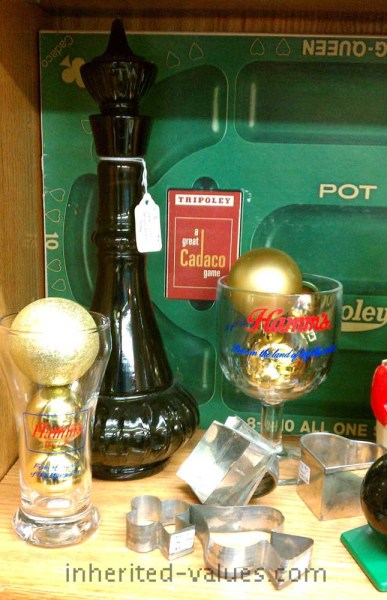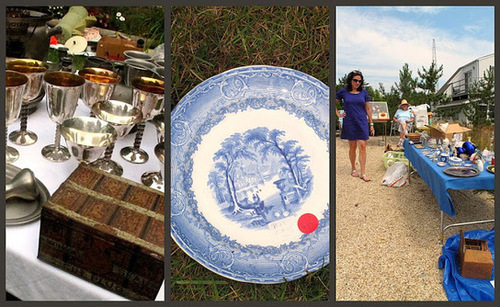If you’ve spent any time talking with other collectors, antiquers, dealers, or folks who just enjoy watching the plethora of collecting shows, you’ve been hearing an increase in the term “mid-century modern .” Loosely applied, the term can mean anything made in the middle of the last, or 20th, century, usually 1940-1960. But more aptly, the term applies to a design aesthetic which embraces the marriage between function and form — with a simplicity of style born of the artistic and cultural movement of Modernism. And because of the “modern” in “mid-century modern”, the style dates back much further than the name implies.
.” Loosely applied, the term can mean anything made in the middle of the last, or 20th, century, usually 1940-1960. But more aptly, the term applies to a design aesthetic which embraces the marriage between function and form — with a simplicity of style born of the artistic and cultural movement of Modernism. And because of the “modern” in “mid-century modern”, the style dates back much further than the name implies.

Modernism is more than just an artistic style; it’s a cultural movement. The movement’s origins go far back as the 1880s, to Germany before the first World War. Despite, or perhaps because of, the prevailing conservatism, there was an increased interest in what the Germans considered the very American notion of usefulness — or, as Dennis Crockett phrased it in his book, German Post-Expressionism: The Art of the Great Disorder 1918-1924, the “predilection for functional work.”
This philosophy, called Neues Bauen or New Objectivity, was first or most notably employed in addressing the German housing crisis of the time. The physical design application of New Objectivity resulted in design innovations in architecture, in which the commercial need for cost-effective housing was met with a radically simplified yet dynamic functionalism, offering simplicity, health, and beauty for the occupants. This solidified the notion that mass-production was indeed reconcilable with individual artistic spirit — it meant affordability — and it was something the famous Bauhaus would build upon when it was founded by Walter Gropius in 1919.


Widely acknowledged as the the first academy for design in the world, the Bauhaus manifesto includes the declaration “to create a new unity of crafts, art and technology.” It was here students and artists would focus on the craftsmanship and the manufacture of works in a collaborative setting, “to produce a work that is not limited to its purely aesthetic meaning, but supports and even influences the transformation of social reality and thus shapes a new society.” And at this time, the transformation desired was a modern one of simplicity and functionality. (For more on the Bauhaus movement and the artists themselves, I highly recommend a book I’ve been reading The Bauhaus Group: Six Masters of Modernism, by Nicholas Fox Weber. It’s fascinating!) Here is where mid-century modern truly begins.

Because the Bauhaus produced more than a mere decorative style, because it pushed the values and needs of a modern world, the school, the artists, and the works created would inspire many others throughout the (mainly Western) world. Spurred on by urban living and the rapid development of plastics and other materials, mid-century modernism became quite popular.
Some of the most known — and collected names — in what we now call mid-century modern, were influenced by the Bauhaus and the movement. They include Americans Ray and Charles Eames (who made fabulous toys too!); Brits Robin Day and his wife Lucienne, and Ernest Race; the Japanese designer and sculptor Isamu Noguchi; and Scandinavians Børge Mogensen, Arne Jacobsen, Finn Juhl (PDF), and Hans Wegner. (Because of the latter design giants, mid-century modern overlaps with, and is often confused for, Scandinavian or Danish design. Here the date of creation and manufacture help make the final decision.)
Here’s a photo of mid-century modern designers George Nelson, Edward Wormley, Eero Saainen (who died not long after this photo was taken), Harry Bertoia, Charles Eames, and Jens Risom for an article in Playboy, July 1961 .
.

Furniture wasn’t the only thing affected by mid-century modernist design. Other functional household objects, such as clocks, radios, and lamps (this was the start of lava lamps!) were made — and are heavily collected today.
Housewares, kitchenalia, and decorative items also got the mid-century modern treatment. You’ll see lots of geometric yet sleek pottery and glassware with embossed patterns and lines of the mid-century mod design. While there still were the more traditional shapes and forms, some with more elaborate and fancy painted designs, made during this time too (Hey, not everyone hops on the trends!), the mid-century modern look is most readily identified by its design simplicity. The decorations seem to better fit the form and function of the piece. Look for pieces in solid colors with embossed designs which seem to flow along the lines of the piece rather than appear applied to it. And remember, one of the primary influences of the movement was purposefulness; meaning the design is wed to an item of purpose and function. When it comes to pieces of decorative turquoise California pottery, for example, there’s less usefulness and practicality than there is with a chair, lamp, or piece of refrigerator glass… However, the style is often represented in these pieces more decorative than functional items and collectors do like them.

Mid-century modern as a category of collecting dates from the 1930s through the mid-1960s. Because of the dates involved, mid-century modern overlaps, influences, and to some degree encapsulates designs from the Atomic Era, Space Age and Googie design, California Modernism, etc. These innovative and popular designs of the 20th century not only pioneered modern furniture and industrial design, but are now the iconic pieces we think of when we think of these decades.
Truly defining or identifying mid-century modern pieces may be difficult; but like Justice Potter said of pornography, you’ll know it when you see it.
Image Credits: (In order images appear.) Photo of Keck & Keck home, via; photos of the Bauhaus Haus am Horn kitchen, 1923, and containers designed by Theodor Bogler for the kitchen and the Josef Albers set of four stacking tables (1927), via; designers photo from Playboy, via; and photo of vintage mid-century modern Westinghouse beige pottery refrigerator-ware pitcher, via.
 Vintage metal skirt hangers are a great way to display photographs, postcards, and other pieces of ephemera. As the clips can be slid along the bars (to accommodate for various waist sizes), you can vary the arrangement of multiple items. If you have smaller pieces, you can even add clothespins to display more items.
Vintage metal skirt hangers are a great way to display photographs, postcards, and other pieces of ephemera. As the clips can be slid along the bars (to accommodate for various waist sizes), you can vary the arrangement of multiple items. If you have smaller pieces, you can even add clothespins to display more items.




















































































